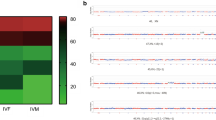Abstract
Purpose
To assess early embryonic developmental potential of embryos affected by maternally inherited meiotic aneuploidies.
Methods
This observational, descriptive study includes 930 oocytes from 151 patients which were retrospectively analyzed by combining the morphological assessment with the genetic results from polar body diagnosis.
Results
Of 930 oocytes examined, 566 (60.9%) were tested aneuploid. Developmental potential until cleavage stage was not affected by trisomies or monosomies (69.6% vs. 77.1%, p = 0.75). However, trisomies significantly more often resulted in top quality cleavage stage embryos compared to monosomies (20% vs. 17.6%, p = < 0.01). Top quality blastocysts were more likely to be euploid than aneuploid (52.4% vs. 47.6%, p = 0.032). Additionally, significantly more aneuploid embryos resulted in developmental arrest compared to euploid embryos (15.3% vs. 6.7%, p = 0.003). Overall, there was no significant difference in the frequency of trisomies and monosomies in blastocyst stage embryos. (28.3% vs. 28.2%; p = 0.81). In contrast to earlier developmental stages, distribution of trisomies and monosomies did not differ in top quality blastocysts (8.3% vs. 5.3%, p = 0.32). However, certain chromosomal abnormalities showed a higher potential to develop into a top-rated blastocyst. These included monosomies 2, 5, 8, 10, 16, 17, 20, 21, and 22 and trisomies 2, 4, 5, 8, 9, 10, 11, 12, 13, 16, 17, 18 and 20.
Conclusion
Meiotically induced maternal aneuploidies have different effects on early embryonic development. While no difference in developmental potential between monosomies and trisomies could be observed in blastocysts, cleavage stage quality was significantly affected by chromosomal aneuploidies.






Similar content being viewed by others
References
Inhorn MC, Patrizio P. Infertility around the globe: new thinking on gender, reproductive technologies and global movements in the 21st century. Hum Reprod Update. 2015;21(4):411–26.
Gruhn JR, Zielinska AP, Shukla V, Blanshard R, Capalbo A, Cimadomo D, et al. Chromosome errors in human eggs shape natural fertility over reproductive life span. Science. 2019;365(6460):1466–9.
Hassold T, Hunt P. To err (meiotically) is human: the genesis of human aneuploidy. Nat Rev Genet. 2001;2(4):280–91.
Lodge C, Herbert M. Oocyte aneuploidy—more tools to tackle an old problem. Proc Natl Acad Sci. 2020;117(22):11850–2.
Schenk M, Groselj-Strele A, Eberhard K, Feldmeier E, Kastelic D, Cerk S, et al. Impact of polar body biopsy on embryo morphokinetics-back to the roots in preimplantation genetic testing? J Assist Reprod Genet. 2018;35(8):1521–8.
Verpoest W, Staessen C, Bossuyt PM, Goossens V, Altarescu G, Bonduelle M, et al. Preimplantation genetic testing for aneuploidy by microarray analysis of polar bodies in advanced maternal age: a randomized clinical trial. Hum Reprod. 2018;33(9):1767–76.
Feichtinger M, Stopp T, Gobl C, Feichtinger E, Vaccari E, Madel U, et al. Increasing live birth rate by preimplantation genetic screening of pooled polar bodies using array comparative genomic hybridization. PLoS One. 2015;10(5):e0128317.
Feichtinger M, Gobl C, Weghofer A, Feichtinger W. Reproductive outcome in European and Middle Eastern/North African patients. Reprod Biomed Online. 2016;33(6):684–9.
ESHRE PGT Consortium and SIG-Embryology Biopsy Working Group, Kokkali G, Coticchio G, Bronet F, Celebi C, et al. ESHRE PGT Consortium and SIG Embryology good practice recommendations for polar body and embryo biopsy for PGT. Hum Reprod Open. 2020; 2020(3):hoaa020.
Alpha Scientists in Reproductive Medicine and ESHRE Special Interest Group of Embryology. The Istanbul consensus workshop on embryo assessment: proceedings of an expert meeting. Hum Reprod. 2011;26(6):1270–83.
Reignier A, Lammers J, Barriere P, Freour T. Can time-lapse parameters predict embryo ploidy? A systematic review. Reprod Biomed Online. 2018;36(4):380–7.
Franasiak JM, Forman EJ, Hong KH, Werner MD, Upham KM, Treff NR, et al. The nature of aneuploidy with increasing age of the female partner: a review of 15,169 consecutive trophectoderm biopsies evaluated with comprehensive chromosomal screening. Fertil Steril. 2014;101(3):656-663 e1.
Lam A, Capuzzo M, Imbrogno MG, Donno V, Spedicato GA, Sacchi S, et al. The complex relationship between female age and embryo euploidy. Minerva Obstet Gynecol. 2021;73(1):103–10.
Coelho FF, Marques FK, Gonçalves MS, Almeida VC, Mateo EC, Ferreira AC. Detection of aneuploidies in spontaneous abortions by quantitative fluorescent PCR with short tandem repeat markers: a retrospective study. . Genet Mol Res. 2016;23(3):15.
Viotti M. Preimplantation Genetic Testing for Chromosomal Abnormalities: Aneuploidy, Mosaicism, and Structural Rearrangements. Genes (Basel). 2020;11(6):602.
Antonarakis SE, Skotko BG, Rafii MS, Strydom A, Pape SE, Bianchi DW, et al. Down syndrome. Nat Rev Dis Primers. 2020;6(1):9.
Author information
Authors and Affiliations
Corresponding author
Ethics declarations
Conflict of interest
None.
Additional information
Publisher's note
Springer Nature remains neutral with regard to jurisdictional claims in published maps and institutional affiliations.
Supplementary Information
Below is the link to the electronic supplementary material.
Rights and permissions
Springer Nature or its licensor (e.g. a society or other partner) holds exclusive rights to this article under a publishing agreement with the author(s) or other rightsholder(s); author self-archiving of the accepted manuscript version of this article is solely governed by the terms of such publishing agreement and applicable law.
About this article
Cite this article
L., T., A., E., L., C. et al. Impact of maternally derived meiotic aneuploidies on early embryonic development in vitro. J Assist Reprod Genet 40, 2715–2723 (2023). https://doi.org/10.1007/s10815-023-02922-9
Received:
Accepted:
Published:
Issue Date:
DOI: https://doi.org/10.1007/s10815-023-02922-9




